to deliver fuel to the engine’s cylinders for combustion. However, they do so in distinct ways, each with its own set of advantages and trade-offs. In this article, we will explore the principles, benefits, and drawbacks of Direct Injection and Port Fuel Injection and their impact on modern engine design and performance.
Fuel injection systems are the lifeblood of modern engines, tasked with the critical role of delivering fuel to the engine’s cylinders for combustion. While both Direct Injection (DI) and Port Fuel Injection (PFI) systems accomplish this essential function, they do so in distinct ways, each bearing its own unique advantages and trade-offs. In this comprehensive exploration, we will delve into the fundamental principles, the manifold benefits, and the nuanced drawbacks of Direct Injection and Port Fuel Injection. Additionally, we will examine how these two injection methods have revolutionized modern engine design and performance, shaping the automotive landscape.
The Fuel Injection Dichotomy: DI vs. PFI
At the heart of understanding Direct Injection and Port Fuel Injection lies the critical differentiation in how they introduce fuel into the engine’s combustion chamber:
Direct Injection (DI): In DI systems, fuel is delivered directly into the combustion chamber, precisely at the moment when it is needed for ignition. High-pressure injectors atomize the fuel, allowing it to mix intimately with the air. This intimate mixing, along with precise control, leads to efficient combustion and power generation.
Port Fuel Injection (PFI): PFI systems, on the other hand, introduce fuel upstream of the intake valves, typically in the intake manifold or port. Here, the fuel mixes with incoming air as it flows toward the combustion chamber. This premixing occurs before the air enters the cylinder, where the spark plug ignites the mixture.
The Advantages and Trade-offs of DI and PFI:
Now, let’s explore the distinctive advantages and trade-offs associated with these two injection methods:
Direct Injection (DI):
Efficiency and Power: DI systems excel in delivering precise amounts of fuel directly into the combustion chamber. This precision optimizes the air-fuel mixture, enhancing combustion efficiency and power output. As a result, DI-equipped engines often deliver higher horsepower and torque, making them popular in performance-oriented and fuel-efficient vehicles.
Emissions Reduction: DI contributes to reduced emissions by promoting more complete combustion. The precise control over fuel delivery minimizes unburned hydrocarbons and other pollutants, aligning with stringent emissions regulations.
Fuel Economy: Improved combustion efficiency translates into better fuel economy, which is a key factor in meeting fuel efficiency standards and consumer demands for economical vehicles.
Port Fuel Injection (PFI):
Simplicity and Cost-Effectiveness: PFI systems are relatively simple and cost-effective compared to DI systems. Their design is well-established, making them a popular choice in many conventional vehicles.
Smooth Idling and Low RPM Performance: PFI systems provide stable and smooth idling, making them ideal for low RPM performance and everyday driving conditions where precise control over combustion is less critical.
Cylinder Wall Cooling: In PFI, the fuel is introduced upstream of the intake valves, which can have a cooling effect on the cylinder walls. This cooling can be beneficial in high-performance and turbocharged engines where heat management is crucial.
Impact on Modern Engine Design and Performance:
The choice between DI and PFI has a profound impact on modern engine design and performance characteristics. Automakers carefully select the injection method based on the intended application, balancing factors like power, efficiency, emissions, and cost.
Hybrid Approaches: Some engines employ a combination of both DI and PFI, leveraging the strengths of each system. This hybrid approach optimizes performance and efficiency across a broader RPM range.
Emissions Compliance: DI has become increasingly prevalent due to its emissions-reducing capabilities. Automakers use DI to meet stringent emissions standards while maintaining or even enhancing engine performance.
Turbocharged Engines: DI is commonly found in turbocharged engines, where precise control over fuel delivery is critical for maximizing power output and efficiency.
Economical Vehicles: PFI remains a favored choice in vehicles where cost-effectiveness and simplicity are paramount, especially in everyday commuting and entry-level models.
In conclusion, the choice between Direct Injection (DI) and Port Fuel Injection (PFI) represents a pivotal decision in modern engine design. These injection methods not only impact an engine’s power, efficiency, and emissions but also influence the overall driving experience. As the automotive industry continues to evolve, engineers will leverage the strengths of both DI and PFI to create engines that meet the diverse needs of consumers, from fuel-efficient daily drivers to high-performance machines. Understanding the principles and trade-offs of these fuel injection systems is key to appreciating the intricate engineering behind the vehicles we drive today.
If you’d like to dive deeper into this subject, there’s more to discover on this page: High octane number ethanol–gasoline blends: Quantifying the …
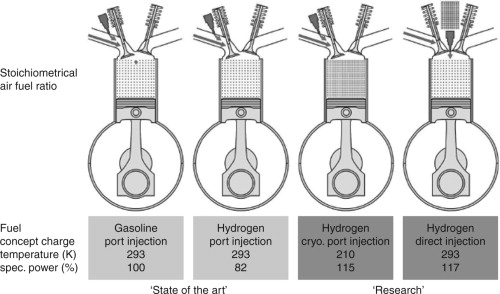
Port Fuel Injection, commonly referred to as PFI, is a traditional method of delivering fuel to an engine’s cylinders. In PFI systems, fuel is injected upstream of the intake valve, typically into the intake manifold or port, before it enters the combustion chamber. Here’s how PFI works:
Port Fuel Injection (PFI), often regarded as the stalwart of fuel delivery systems in the automotive world, represents a tried-and-true method for efficiently and reliably feeding an engine’s hunger for fuel. Its straightforward approach to fuel injection has earned it a place in the annals of automotive history and continues to power millions of vehicles around the globe.
Pre-Combustion Fuel Delivery: At the heart of PFI lies the concept of pre-combustion fuel delivery. Unlike some of the more recent innovations in fuel injection, where fuel is directly injected into the combustion chamber, PFI systems introduce fuel into the intake manifold or port, just upstream of the intake valve. This positioning allows the fuel to mix with incoming air before entering the combustion chamber, resulting in a homogeneous air-fuel mixture.
Fuel Atomization: As fuel is introduced into the intake port, it’s crucially important that it is atomized into fine droplets. Proper atomization ensures that the fuel can thoroughly mix with the incoming air, promoting efficient combustion. To achieve this, PFI systems often employ carefully designed injectors that break the fuel into tiny droplets, enhancing the combustion process and minimizing emissions.
Precision Timing: Timing is of the essence in PFI systems. The injectors must precisely meter and deliver the right amount of fuel at the right moment in the engine’s cycle. This timing control is typically synchronized with the engine’s crankshaft position and speed, ensuring that the right amount of fuel is injected for every revolution of the engine. Such precision plays a pivotal role in optimizing fuel efficiency, power output, and emissions.
Adaptability and Reliability: PFI systems are celebrated for their adaptability and reliability. They are well-suited to a wide range of engines, from small commuter cars to powerful trucks and SUVs. This versatility has contributed to their enduring popularity in the automotive industry. Additionally, PFI systems tend to be less complex and more robust than some of their more modern counterparts, making them less prone to failure and easier to maintain.
Evolutionary Steps: While PFI represents a traditional method of fuel injection, it has not remained static over the years. Engineers have continued to refine and improve PFI systems, introducing features like multi-point injection (MPI) where each cylinder has its injector, leading to even more precise fuel delivery. These advancements have allowed PFI to keep pace with evolving emission standards and efficiency expectations.
Environmental Considerations: PFI systems have played a role in reducing emissions and improving fuel efficiency. Through precise fuel metering and optimization of air-fuel mixtures, they contribute to cleaner combustion and lower greenhouse gas emissions.
In conclusion, Port Fuel Injection (PFI) is a testament to the enduring principles of simplicity, reliability, and adaptability in automotive engineering. Its ability to deliver fuel precisely to the intake ports, optimize combustion, and adapt to a wide range of engine types has secured its place in the automotive landscape. As the industry continues to evolve, PFI systems remain a dependable and efficient means of fuel delivery, meeting the needs of vehicles and drivers around the world.
For additional details, consider exploring the related content available here Is the H2 economy realizable in the foreseeable future? Part III: H2 …

In PFI systems, fuel travels from the fuel tank to the engine bay through a fuel line. It is then injected into the intake manifold, where it mixes with incoming air. This air-fuel mixture is drawn into the combustion chamber when the intake valve opens.
In Port Fuel Injection (PFI) systems, the journey of fuel from the fuel tank to the combustion chamber is a meticulously controlled process that plays a crucial role in engine performance and efficiency. Let’s explore this process in greater detail:
Fuel Delivery: The journey begins with the fuel pump, which pressurizes fuel in the tank. This pressurized fuel is then conveyed through a fuel line to the engine bay. The fuel pump’s ability to maintain the right pressure is vital for consistent fuel delivery.
Precise Metering: As the fuel arrives in the engine bay, it passes through the fuel injector nozzles, which are strategically positioned near the intake valves. These injectors are equipped with precise mechanisms that allow them to meter the fuel flow with exceptional accuracy. This metering ensures that the engine receives the correct amount of fuel for each cycle, optimizing combustion efficiency.
Mixing with Air: The injected fuel enters the intake manifold, where it awaits its rendezvous with incoming air. The manifold’s design and configuration play a role in achieving efficient mixing. The air and fuel must combine thoroughly to create a homogenous air-fuel mixture.
Enhanced Combustion: The air-fuel mixture is drawn into the combustion chamber when the intake valve opens. This synchronized operation is crucial for precise combustion timing. The mixture is then compressed by the piston, creating the conditions necessary for efficient combustion.
Fuel Atomization: Within the combustion chamber, the fuel undergoes further atomization. This means that the fuel droplets are broken down into finer particles, enhancing their ability to mix with air and ignite evenly. Well-atomized fuel contributes to more complete combustion, reducing emissions and improving fuel efficiency.
Optimizing Air-Fuel Ratios: The fine control offered by PFI systems allows for the precise adjustment of air-fuel ratios based on driving conditions. During acceleration or high-load scenarios, more fuel can be injected for increased power, while during cruising, the system can lean out the mixture to improve fuel economy.
Response and Drivability: PFI systems offer rapid response times, allowing for quick adjustments to changing throttle inputs. This responsiveness enhances vehicle drivability, ensuring smooth acceleration and minimal lag when power is demanded.
Emissions Control: The precise metering and control of the air-fuel mixture in PFI systems contribute to lower emissions. This is particularly important in meeting stringent emissions standards, as it enables the use of advanced emissions control technologies, such as catalytic converters and oxygen sensors.
Future Adaptability: PFI systems remain a versatile and adaptable technology that can be integrated with other advanced engine technologies, including turbocharging and hybrid powertrains. This adaptability positions PFI as a key component in the evolving landscape of internal combustion engines.
In conclusion, the journey of fuel in Port Fuel Injection (PFI) systems is a meticulously orchestrated process, with each step carefully designed to optimize engine performance, efficiency, and emissions control. As automotive technology continues to evolve, PFI systems remain a cornerstone in achieving the delicate balance between power, efficiency, and environmental responsibility in internal combustion engines.
For a comprehensive look at this subject, we invite you to read more on this dedicated page: CBR1000RR Engine Technology
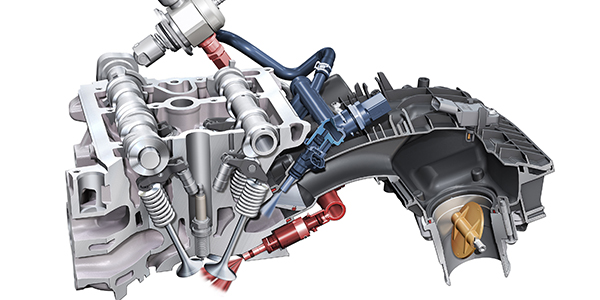
PFI injectors produce a fine spray of fuel that is evenly distributed across the intake port. This uniform distribution promotes efficient mixing with air and ensures consistent combustion.
Precision Fuel Injection (PFI) injectors stand as a testament to the meticulous engineering that underpins modern combustion engines. Their ability to produce a finely atomized spray of fuel, expertly balanced and uniformly distributed, is a critical element in the pursuit of efficient and clean combustion:
Atomized Fuel Mastery: PFI injectors are virtuosos of fuel atomization. They break down the liquid fuel into minuscule droplets, akin to a fine mist, ensuring that each droplet is of consistent size. This uniformity is pivotal, as it allows for an even dispersion of fuel throughout the incoming air charge.
Air-Fuel Mixing Perfection: The evenly distributed fuel spray interfaces with the incoming air in the intake port with exceptional precision. This perfect marriage of fuel and air is a hallmark of efficient combustion. When fuel and air mix uniformly, there are no pockets of excess fuel or air—only a harmonious blend that burns completely and cleanly.
Combustion Consistency: The importance of uniform fuel distribution becomes even more apparent during the combustion process. A precisely atomized fuel spray ensures that every cylinder receives an equal and consistent amount of fuel. This consistency results in uniform combustion across all cylinders, promoting smooth engine operation and preventing issues like knocking or misfires.
Efficiency Champion: PFI injectors, by promoting efficient fuel-air mixing and combustion, contribute significantly to engine efficiency. When every droplet of fuel is utilized optimally, there’s less wasted fuel, which translates to improved fuel economy. This efficiency is a win-win for both drivers and the environment, reducing fuel consumption and emissions.
Emissions Minimization: Efficient combustion is the linchpin in reducing harmful emissions from internal combustion engines. PFI injectors play a vital role in this endeavor by ensuring that fuel is consumed thoroughly, leaving little room for unburned hydrocarbons or other pollutants in the exhaust gases.
Smooth and Responsive Performance: The precision of PFI injectors extends to the engine’s responsiveness. With consistent fuel distribution and combustion, drivers experience smooth and predictable throttle response. Whether accelerating from a standstill or cruising at highway speeds, the engine behaves predictably and efficiently.
Adaptability and Control: Modern PFI systems are not static; they adapt to changing driving conditions in real-time. Advanced engine management systems monitor various parameters, such as engine load, temperature, and altitude, and adjust fuel injection accordingly. This adaptability ensures that the engine consistently operates at its peak efficiency, regardless of external factors.
Technology Evolution: The development of PFI injectors has evolved with advancements in materials and precision manufacturing techniques. These innovations have led to increasingly efficient and reliable injector designs, further enhancing the benefits of PFI technology.
In essence, Precision Fuel Injection injectors are instrumental in orchestrating the symphony of combustion within modern engines. Their precision and consistency in fuel delivery set the stage for optimal engine performance, efficiency, and emissions control. As engines continue to evolve to meet ever-stringent efficiency and emissions standards, PFI injectors remain a cornerstone of engineering excellence in the automotive world.
To delve further into this matter, we encourage you to check out the additional resources provided here: No-Rosion Products Technical Questions and Answers

Smooth Idle: PFI systems are known for their smooth and stable idle, making them ideal for everyday driving conditions.Lower Nitrogen Oxide (NOx) Emissions: PFI can help reduce NOx emissions due to its ability to cool the intake air, which lowers combustion temperatures.
The advantages of Port Fuel Injection (PFI) systems extend beyond just smooth idling and reduced NOx emissions. Here’s a deeper look at how PFI technology enhances the overall driving experience and environmental impact:
Precise Fuel Delivery: PFI systems are renowned for their precision in delivering fuel to each cylinder. This precision ensures a consistent air-fuel mixture, contributing to smoother engine operation across a wide range of conditions, from idling in traffic to high-speed highway cruising.
Cold Start Performance: PFI systems excel in cold start scenarios. They provide excellent fuel atomization, which promotes quicker combustion and reduces cold-start emissions. This attribute enhances the vehicle’s drivability and minimizes environmental impact during critical start-up moments.
Engine Efficiency: The precise control over the air-fuel mixture afforded by PFI technology enhances engine efficiency. This efficiency translates to improved fuel economy, lowering the cost of ownership for consumers and reducing the overall carbon footprint of the vehicle.
Part-Load Operation: PFI systems offer optimized performance during part-load operation, which is a common driving scenario in everyday use. The ability to precisely meter fuel allows engines to run more efficiently during city driving and other situations where full power is not required.
Reduced Engine Knock: PFI systems can help mitigate engine knock or detonation, a phenomenon where uncontrolled combustion occurs in the engine. This not only safeguards engine components but also contributes to lower emissions by preventing excessive fuel-rich conditions.
Compliance with Emissions Standards: In an era of increasingly stringent emissions regulations, PFI systems play a crucial role in helping vehicles meet these standards. Their ability to maintain precise control over air-fuel ratios facilitates the reduction of harmful pollutants, such as carbon monoxide (CO) and hydrocarbons (HC).
Adaptability to Alternative Fuels: PFI systems are adaptable to a wide range of fuels, including biofuels and ethanol blends. This flexibility aligns with efforts to diversify fuel sources and reduce the carbon intensity of transportation.
Improved Drivability: Beyond the technical advantages, PFI systems contribute to a more enjoyable driving experience. They ensure that the engine operates smoothly and responsively, enhancing driver satisfaction.
Combustion Control: PFI systems enable precise control over the combustion process, which leads to optimal power delivery and reduced emissions. This level of control is essential for meeting the demands of modern, eco-conscious consumers.
Future Innovations: Ongoing research and development efforts continue to refine PFI technology. Innovations in injector design, combustion strategies, and electronic control systems promise even greater efficiency gains and emissions reductions.
In summary, Port Fuel Injection systems represent a tried-and-true technology that offers a multitude of benefits beyond just smooth idling and reduced NOx emissions. They contribute to overall engine efficiency, drivability, and compliance with emissions standards. As automotive technology continues to evolve, PFI systems remain a valuable tool in the pursuit of more sustainable and efficient transportation.
Additionally, you can find further information on this topic by visiting this page: Is the H2 economy realizable in the foreseeable future? Part III: H2 …
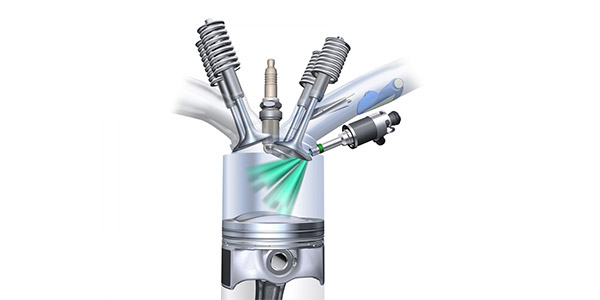
Limited Performance: PFI systems may struggle to provide the precise fuel metering needed for high-performance applications, especially in turbocharged engines.Lower Fuel Efficiency: PFI can be less fuel-efficient than Direct Injection because of the cooling effect it has on the intake air, reducing the thermodynamic efficiency of the engine.
While Port Fuel Injection (PFI) systems have their advantages, they do come with limitations, particularly in scenarios where high-performance and optimal fuel efficiency are paramount:
High-Performance Challenges: In high-performance applications, such as sports cars or turbocharged engines, PFI systems can face limitations. Achieving precise and rapid fuel metering at very high RPMs or under heavy load conditions can be challenging for PFI systems. This can result in lag or hesitation, which can impact the driving experience and the engine’s ability to deliver maximum power.
Turbocharged Engines: Turbocharging relies on the precise control of the air-fuel mixture to optimize combustion and power output. PFI systems may struggle to provide the level of precision needed in turbocharged engines, as the dynamic airflow and pressure changes require rapid and accurate fuel delivery. This can affect the engine’s responsiveness and its ability to harness the full potential of forced induction.
Fuel Efficiency Concerns: PFI systems may exhibit lower fuel efficiency compared to Direct Injection (DI) systems in certain operating conditions. This is partly due to the cooling effect PFI has on the intake air when the fuel is injected into the intake manifold. The cooler air reduces the thermodynamic efficiency of the engine, leading to lower fuel economy, especially during steady-state cruising or light-load conditions.
Incomplete Combustion: In some instances, PFI systems may struggle with incomplete combustion, which can result in unburned hydrocarbons and increased emissions. This is particularly relevant during transient operating conditions, such as rapid throttle changes or start-up, where achieving optimal air-fuel ratios can be challenging.
Emissions Challenges: Meeting stringent emissions standards can be more demanding with PFI systems, especially when it comes to controlling NOx emissions. DI systems, with their ability to precisely control the timing and location of fuel injection, have an advantage in emissions reduction.
Combustion Chamber Deposits: PFI systems can be more prone to carbon buildup on intake valves and in the combustion chamber due to the absence of fuel spray directly on these surfaces. This carbon buildup, known as carbon fouling, can lead to reduced engine efficiency and performance over time.
Transition to DI: In response to these limitations, many automakers are transitioning from PFI to a combination of PFI and Direct Injection (DI) systems, known as dual-injection systems. This hybrid approach seeks to harness the strengths of both systems, optimizing performance, efficiency, and emissions control.
Fuel Quality Sensitivity: PFI systems can be sensitive to variations in fuel quality. Fuel with inconsistent properties, such as octane rating and volatility, can affect the performance and efficiency of PFI-equipped engines.
In summary, while Port Fuel Injection (PFI) systems have been a staple in the automotive industry for decades, they do have limitations in high-performance and fuel efficiency-critical scenarios. The cooling effect on intake air, challenges in precise fuel metering, and emissions control can make PFI less suitable for certain applications, leading to the emergence of hybrid dual-injection systems and a shift toward Direct Injection (DI) technology to meet the evolving demands of modern engines and environmental standards.
Should you desire more in-depth information, it’s available for your perusal on this page: Why does only direct injection engines are turbocharged in petrol …
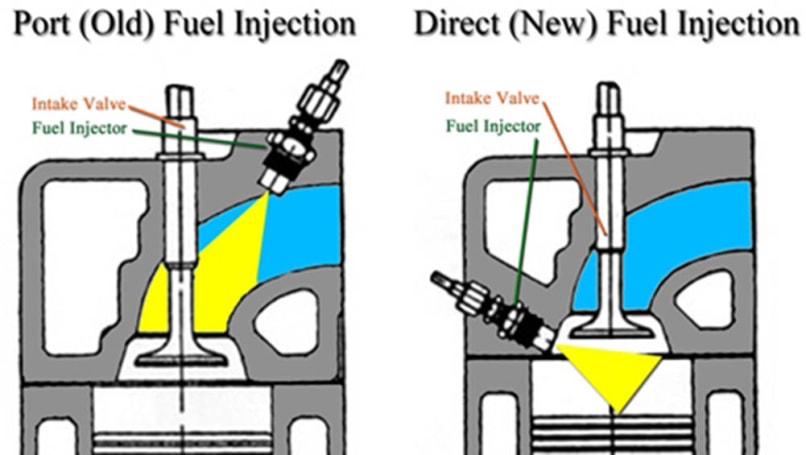
Direct Injection, or DI, represents a more modern approach to fuel delivery. In DI systems, fuel is injected directly into the combustion chamber, bypassing the intake manifold and intake valve. Here’s how DI works:
Direct Injection (DI) is a testament to the relentless pursuit of fuel efficiency and engine performance. This modern approach to fuel delivery reimagines the combustion process by precisely delivering fuel directly into the heart of the combustion chamber. This departure from traditional port fuel injection offers a host of benefits that transform the way engines operate. Let’s delve into the intricate workings of DI:
Precision Fuel Delivery: DI systems are engineered to deliver fuel with exceptional precision directly into the combustion chamber. This precise control allows for optimal air-fuel mixture ratios, enhancing combustion efficiency and power output.
Improved Atomization: Fuel atomization, the process of breaking fuel into tiny droplets, is critical for efficient combustion. In DI, the high-pressure injectors disperse fuel into a fine mist, ensuring thorough mixing with incoming air. This fine mist promotes more complete combustion, reducing emissions and enhancing fuel efficiency.
Cooler Intake Charge: Since fuel is injected directly into the combustion chamber, it has a cooling effect on the surrounding air. This cooler intake charge helps prevent knocking or pre-ignition, allowing for higher compression ratios and more efficient engine operation.
Adaptive Timing: DI systems often work in tandem with advanced engine control units (ECUs) and sensors. This synergy enables adaptive timing, allowing the ECU to adjust fuel injection timing and duration based on real-time data. It optimizes performance across a range of driving conditions, from idling in traffic to accelerating on the highway.
Reduced Fuel Consumption: One of the standout advantages of DI is its ability to maximize fuel efficiency. By delivering fuel directly into the combustion chamber during the power stroke, DI minimizes waste and optimizes the energy extracted from each drop of fuel. This translates into fewer trips to the gas station and reduced carbon emissions.
Lower Emissions: DI contributes to lower emissions by promoting cleaner and more efficient combustion. The precise fuel delivery and improved atomization reduce the production of harmful pollutants, helping engines meet stringent emissions standards.
Turbocharged Performance: DI is often paired with turbocharging or supercharging to enhance engine performance. The combination of these technologies delivers a potent and efficient driving experience, offering impressive power while maintaining fuel efficiency.
Enhanced Reliability: The precise control offered by DI systems can also contribute to engine reliability. By optimizing combustion, DI reduces wear and tear on engine components, extending their lifespan.
Adaptable Across Vehicle Types: DI technology is adaptable to a wide range of vehicle types, from compact cars to trucks and SUVs. It is a versatile solution that enhances performance and efficiency across various automotive segments.
Future Evolution: As automotive technology continues to evolve, DI systems are likely to see further improvements. Innovations in injector design, fuel delivery strategies, and engine management will continue to refine the efficiency and performance of DI-equipped engines.
In essence, Direct Injection represents a transformative leap in engine technology, optimizing combustion, fuel efficiency, and power output. As automakers and engineers continue to fine-tune and expand the capabilities of DI systems, they will remain a cornerstone of modern engine design, driving the pursuit of greener, more efficient, and more responsive vehicles for years to come.
For a comprehensive look at this subject, we invite you to read more on this dedicated page: LPG for Heavy Duty Engines Buses, Trucks, Marine and Other …
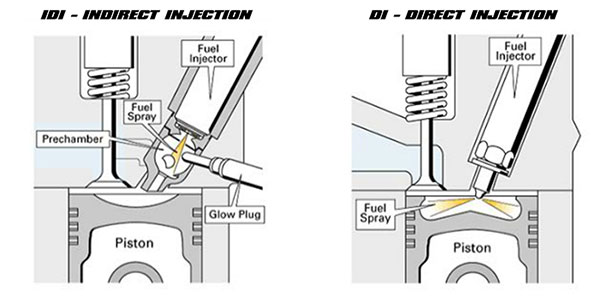
DI systems use high-pressure fuel injectors that spray fuel directly into the combustion chamber. This allows for precise control of fuel delivery, as the fuel is introduced at the exact moment and in the precise quantity needed for combustion.
The precision offered by Direct Injection (DI) systems is a game-changer in the realm of fuel delivery. Here’s an in-depth look at how DI systems achieve this remarkable level of control:
Pressure and Precision: DI systems employ high-pressure fuel injectors capable of delivering fuel at pressures exceeding 2,000 psi (pounds per square inch). This extreme pressure allows for the fuel to be atomized into tiny droplets, resembling a fine mist. Such atomization ensures that the fuel is distributed evenly throughout the combustion chamber.
Timing is Everything: In the world of internal combustion engines, timing is critical. DI systems take full advantage of this by injecting fuel with pinpoint accuracy. The precise moment when the injector releases fuel is determined by the engine’s control unit, taking into account factors like engine speed, load, temperature, and throttle position. This results in optimal combustion efficiency under a wide range of conditions.
Quantity Control: Beyond precise timing, DI systems excel in controlling the quantity of fuel delivered. The injectors can meter fuel down to the millisecond and in minuscule quantities, ensuring that only the necessary amount for combustion is introduced. This fine-grained control minimizes waste and maximizes the efficiency of the combustion process.
Adapting to Driving Conditions: DI systems are adaptive and can respond to changes in driving conditions in real-time. When you’re cruising at a constant speed, for example, the DI system can deliver just enough fuel to maintain engine operation without excess fuel consumption. However, when you demand quick acceleration or high power output, the DI system instantly adjusts to provide the required fuel for robust performance.
Combustion Efficiency: Perhaps the most significant advantage of this level of control is the enhancement of combustion efficiency. By introducing fuel directly into the combustion chamber, DI systems enable a leaner air-fuel mixture when needed, resulting in more thorough combustion. This translates into improved fuel economy and reduced emissions, contributing to both environmental sustainability and cost savings for the driver.
Turbocharging Synergy: DI systems have found a natural synergy with turbocharging technology. Turbocharged DI engines are known for their ability to deliver substantial power gains while maintaining good fuel efficiency. The precise control over fuel delivery ensures that the turbocharger receives the optimal air-fuel mixture for power production, enhancing overall engine performance.
Challenges and Benefits: While DI systems offer numerous advantages, they are not without challenges. One issue is the potential for carbon buildup on intake valves due to the absence of fuel washing over them. However, automakers are continually developing solutions to mitigate this concern, ensuring long-term reliability and efficiency.
In conclusion, Direct Injection (DI) systems are a testament to the meticulous engineering and advanced technology that drives the automotive industry forward. Their precision in fuel delivery, coupled with adaptability to changing driving conditions, elevates engine performance, fuel efficiency, and emissions control to new heights. As DI systems continue to evolve, we can expect further refinements that will shape the future of automotive powertrains, ultimately benefitting both drivers and the environment.
Looking for more insights? You’ll find them right here in our extended coverage: FreedomCAR and Fuel Partnership 2008 Highlights of Technical …
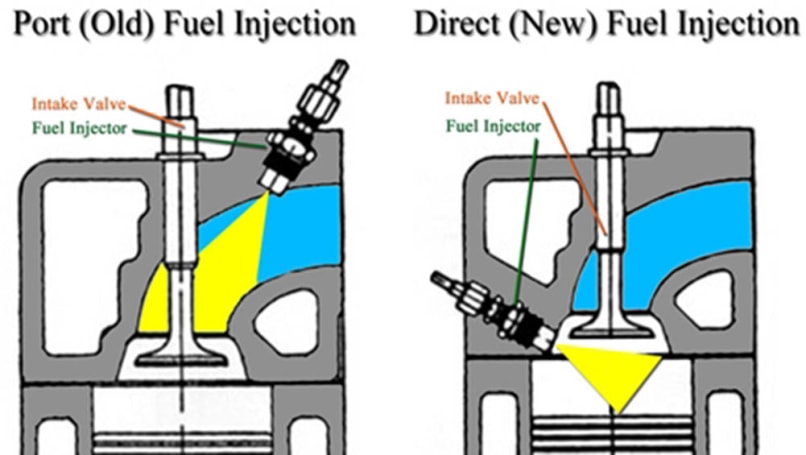
DI injectors produce a concentrated fuel spray that is directed into the combustion chamber. This results in improved atomization and more efficient combustion.
Direct Injection (DI) injectors are the precision instruments at the forefront of modern engine design, and their impact on combustion efficiency cannot be overstated. These injectors represent a technological leap in the quest for optimal power generation and fuel economy. Let’s delve deeper into the intricacies of DI injectors and how they revolutionize combustion:
The Precision of DI Injectors:
DI injectors operate with meticulous precision, delivering fuel directly into the combustion chamber at the most opportune moment. This precision is underpinned by several key elements:
Concentrated Fuel Spray: DI injectors produce a tightly focused fuel spray that’s akin to a fine mist. This concentration ensures that the fuel is uniformly distributed within the combustion chamber, leaving no nook or cranny untouched. This contrasts with older, port fuel injection systems, where fuel is introduced upstream of the intake valves and can sometimes condense on the cold intake walls, leading to incomplete combustion.
Optimized Atomization: The fine mist created by DI injectors results in exceptional atomization, breaking down the fuel into tiny, uniform droplets. These droplets mix thoroughly with the incoming air, creating a homogenous air-fuel mixture. The result is a combustion process that is more complete and efficient.
Improved Combustion Dynamics: The precise control of fuel delivery allows DI systems to achieve a leaner air-fuel mixture when required. This leaner mixture contains less fuel but a higher proportion of air, which is essential for efficient combustion and reduced emissions. When more power is needed, DI injectors can instantly adjust to provide a richer mixture, optimizing power output.
The Advantages of DI Injectors:
The concentrated fuel spray and precise atomization achieved by DI injectors translate into a host of tangible benefits:
Enhanced Combustion Efficiency: The ability to create a finely atomized air-fuel mixture ensures that combustion is thorough and efficient. This leads to more power extracted from the same amount of fuel and fewer unburned hydrocarbons, resulting in increased fuel economy.
Power and Torque: DI-equipped engines are known for their impressive power and torque figures. The precise control over the air-fuel mixture allows engineers to fine-tune engine performance, delivering power when needed and economizing during light load conditions.
Emissions Reduction: Improved combustion efficiency directly contributes to reduced emissions. DI systems are particularly effective at lowering levels of harmful pollutants, such as nitrogen oxides (NOx) and particulate matter, aligning with stringent emissions regulations.
Turbocharging Synergy: DI is often coupled with turbocharging to maximize power output. The combination of these technologies enables smaller-displacement engines to produce power levels previously associated with larger, naturally aspirated engines, all while maintaining efficiency.
Precise Control: DI systems offer unparalleled precision in fuel delivery, which is essential for optimizing the engine’s response to varying driving conditions and load demands. This precise control ensures a smooth and responsive driving experience.
In conclusion, Direct Injection (DI) injectors are the architects of combustion perfection in modern engines. Their ability to produce a concentrated fuel spray, optimize atomization, and adapt to changing conditions results in a harmonious balance between power and efficiency. DI injectors are at the forefront of the automotive industry’s efforts to meet evolving emissions standards, improve fuel economy, and provide thrilling driving experiences. As technology continues to advance, we can expect further refinements in DI systems, pushing the boundaries of combustion efficiency and environmental responsibility in the automotive world.
Additionally, you can find further information on this topic by visiting this page: No-Rosion Products Technical Questions and Answers
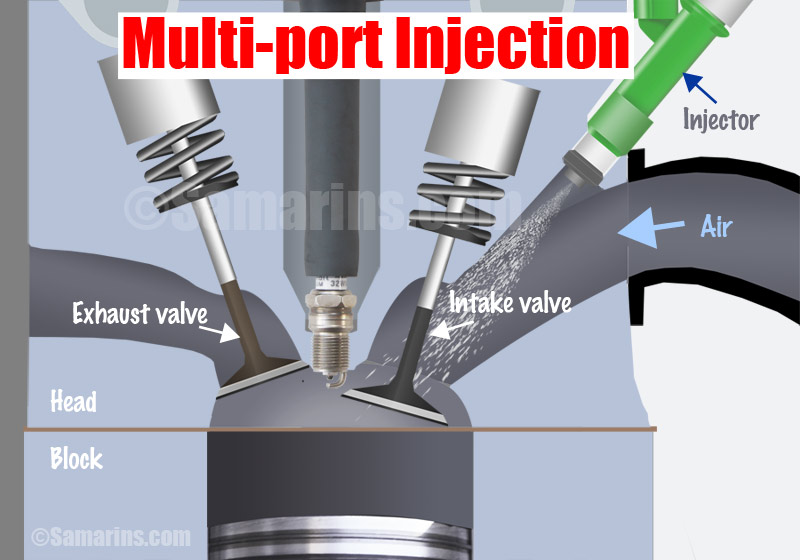
Higher Performance: DI systems offer greater control over fuel delivery, making them well-suited for high-performance applications. This precision allows for increased power and torque.Improved Fuel Efficiency: DI engines can achieve better fuel efficiency by optimizing the air-fuel mixture, resulting in more complete combustion and reduced waste.
Enhanced Combustion Efficiency: One of the cornerstones of Direct Injection (DI) systems is their ability to drastically improve combustion efficiency. By injecting fuel directly into the combustion chamber at the precise moment it’s needed, DI systems create an environment where the air-fuel mixture can be finely tuned for optimal combustion. This means that each drop of fuel is used effectively, leaving little to no wasted fuel behind. The result is not only more power but also significantly reduced emissions, aligning with the growing emphasis on environmental responsibility.
Reduced Knock and Detonation: DI systems offer another advantage—reduced knock and detonation. These undesirable phenomena can limit an engine’s performance and longevity. DI’s precise control over fuel delivery, coupled with the ability to cool the combustion chamber with the incoming air, helps mitigate the risk of knock and detonation. This, in turn, enables engineers to design engines with higher compression ratios, extracting more power and efficiency from each combustion cycle.
Turbocharging Synergy: Direct Injection and turbocharging are a match made in automotive heaven. Turbochargers rely on a dense and precisely timed air-fuel mixture to generate additional power. DI systems provide the perfect companion, as they can deliver fuel directly into the high-pressure air created by the turbocharger. This synergy results in impressive power gains without a significant increase in engine displacement, making smaller, more fuel-efficient engines capable of delivering the performance of larger ones.
Adaptive Performance: DI systems are adaptive performers. Engine control units (ECUs) can continuously adjust the fuel injection timing, duration, and pressure to match driving conditions. Whether you’re cruising on the highway or pushing your vehicle to the limits, DI systems ensure that the engine operates optimally. This adaptability not only enhances performance but also contributes to fuel efficiency and reduced emissions in various driving scenarios.
Challenges and Considerations: While DI systems offer an array of benefits, they are not without their challenges. They require sophisticated control systems and high-pressure fuel pumps, which can increase production costs. Additionally, the buildup of carbon deposits on the intake valves, a common issue with DI engines, necessitates periodic maintenance to ensure continued performance and efficiency.
In summary, Direct Injection (DI) systems represent a technological leap forward in the world of automotive engineering. Their precision in fuel delivery and combustion control not only unlocks higher performance but also delivers improved fuel efficiency and reduced emissions. As automotive manufacturers continue to refine DI technology and address its challenges, it remains a pivotal component in achieving the balance between power, efficiency, and environmental sustainability in modern engines.
For additional details, consider exploring the related content available here Diesel Engines: One Option to Power Future Personal …
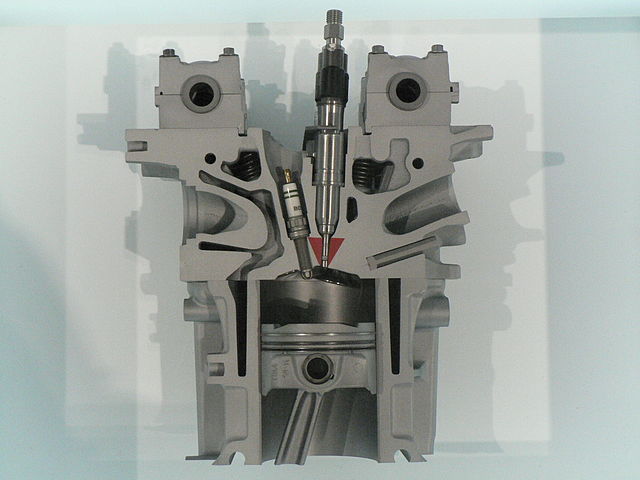
Potential Carbon Buildup: DI engines may be more prone to carbon buildup on intake valves due to the absence of fuel spraying onto them, which can affect long-term reliability and efficiency.Combustion Noise: DI engines can be noisier during combustion due to the direct injection of fuel into the cylinder.
The adoption of Direct Injection (DI) technology in engines has brought about significant improvements in fuel efficiency and power output. However, it’s essential to consider some potential challenges and characteristics associated with DI engines:
Potential Carbon Buildup: While DI engines offer advantages in terms of fuel efficiency, they may be more prone to carbon buildup on the intake valves. In traditional Port Fuel Injection (PFI) engines, fuel is sprayed onto the intake valves, which helps keep them clean. In DI engines, fuel is injected directly into the combustion chamber, bypassing the intake valves. This can lead to a gradual buildup of carbon deposits on the intake valves over time. These deposits, commonly referred to as carbon fouling, can affect engine performance, reduce fuel efficiency, and increase emissions. Manufacturers are addressing this issue with various strategies, including periodic valve cleaning and the use of detergents in the fuel.
Combustion Noise: DI engines tend to be noisier during combustion when compared to PFI engines. The direct injection of fuel into the cylinder can create a sharper, more audible combustion noise. While this noise may not be a significant concern for many drivers, it can be more pronounced in certain operating conditions. Automakers are continually working on noise reduction technologies and sound insulation to mitigate this issue and provide a quieter and more comfortable driving experience.
Higher Compression Ratios: DI technology enables engines to operate with higher compression ratios, which can improve thermal efficiency and power output. However, higher compression ratios can also place greater stress on engine components, potentially leading to increased wear and tear over time. Manufacturers design DI engines with robust components and materials to withstand these higher stresses, but proper maintenance and timely service are crucial to ensuring the engine’s long-term reliability.
Improved Fuel Atomization: One of the benefits of DI is the improved atomization of fuel, resulting in better air-fuel mixing within the combustion chamber. This enhanced mixing contributes to more efficient combustion and improved power delivery. However, it also means that the fuel is exposed to higher temperatures and pressures during combustion, which can lead to increased production of nitrogen oxides (NOx), a pollutant that contributes to air quality issues. Automakers use emissions control technologies like selective catalytic reduction (SCR) to mitigate NOx emissions in DI engines.
Advanced ECU Control: DI engines rely heavily on advanced Engine Control Units (ECUs) to precisely manage fuel injection timing, duration, and pressure. This requires sophisticated sensors and control algorithms. While these systems are highly reliable, they can be more complex to diagnose and repair if issues arise. Proper training and diagnostic tools are essential for maintaining DI engines effectively.
In summary, while Direct Injection (DI) technology offers significant benefits in terms of efficiency and power, it’s important to be aware of potential challenges such as carbon buildup on intake valves and combustion noise. Automotive manufacturers continually work to address these issues through innovative solutions and improved engine designs, ensuring that DI engines provide both performance and longevity while meeting increasingly stringent emissions standards.
For additional details, consider exploring the related content available here Seadoo DI (Direct Injection) Fuel Pump Replacement Guide | Sea …

The choice between PFI and DI has a profound impact on modern engine design. Automakers often adopt a combination of both technologies, known as Dual Injection, to optimize performance and fuel efficiency. For example, PFI may be used for lower-load conditions and at idle, while DI comes into play during higher-load situations for improved power and efficiency.
Additionally, DI has become prevalent in turbocharged engines, where precise control over fuel delivery is crucial for achieving the desired power output without sacrificing fuel efficiency.
The dynamic interplay between Port Fuel Injection (PFI) and Direct Injection (DI) represents a pivotal decision in modern engine design. This choice isn’t merely a matter of preference; it’s a strategic balancing act that engineers perform to maximize the potential of internal combustion engines. Enter the realm of Dual Injection—a harmonious coexistence of PFI and DI technologies that elevates performance, efficiency, and adaptability:
Strategic Synergy: Dual Injection is akin to having two maestros conducting an orchestra, each contributing their unique strengths at the right moments. PFI and DI technologies work in concert, optimizing fuel delivery based on the engine’s operating conditions. This synergy results in a finely tuned engine that delivers power and efficiency precisely when needed.
Low-Load Leverage: PFI takes the lead during low-load conditions and at idle. Its ability to produce a finely atomized spray of fuel and ensure uniform distribution shines in these scenarios. PFI’s role in idling is particularly noteworthy, as it maintains a stable and efficient combustion process at minimal engine loads.
DI’s High-Load Brilliance: As engine demand increases, DI steps into the spotlight. DI excels under high-load situations where precise control over fuel delivery is paramount. Its ability to inject fuel directly into the combustion chamber, timed with exceptional precision, enhances power output while maintaining efficiency.
Turbocharged Triumph: Turbocharged engines, which rely on forced induction to boost power, have embraced DI with open arms. In these engines, the combination of DI and turbocharging is a symphony of technology. DI’s ability to deliver fuel directly into the combustion chamber complements turbocharging’s demand for precise and rapid power delivery. This partnership results in potent engines that offer both exhilarating performance and respectable fuel efficiency.
Advanced Engine Management: Dual Injection is not a static system; it’s dynamic and responsive. Advanced engine management systems continuously monitor various parameters, such as engine load, throttle position, and temperature, to determine the optimal fuel injection strategy. This adaptability ensures that the engine operates efficiently across a wide range of driving conditions.
Emissions Control: Dual Injection plays a pivotal role in emissions control. The ability to tailor fuel delivery precisely allows for more efficient combustion, reducing the production of harmful emissions. This aligns with stringent emissions regulations and helps automakers meet environmental standards.
Future-Proofing: As automotive technology continues to evolve, Dual Injection provides a degree of future-proofing. It offers the flexibility to adapt to changing fuel formulations, emerging regulatory standards, and evolving consumer preferences, making it a versatile choice for automakers.
Customer-Centric Efficiency: Dual Injection caters to a wide spectrum of driver preferences. For the eco-conscious, it offers impressive fuel efficiency. For those who relish spirited driving, it delivers the power and responsiveness expected from modern engines.
In the complex landscape of modern engine design, Dual Injection stands as a testament to ingenuity. It’s an embodiment of the automotive industry’s commitment to delivering vehicles that are not only powerful but also efficient and environmentally responsible. As engineers continue to refine and expand the capabilities of Dual Injection, it remains at the forefront of technology, defining the next generation of internal combustion engines.
Don’t stop here; you can continue your exploration by following this link for more details: FreedomCAR and Fuel Partnership 2008 Highlights of Technical …

Conclusion
The choice between Direct Injection (DI) and Port Fuel Injection (PFI) represents a complex balancing act between performance, efficiency, and emissions. While PFI offers smooth idle and reduced NOx emissions, DI excels in delivering higher performance and improved fuel efficiency. Modern engines often incorporate both technologies to harness their respective strengths for a versatile and efficient powertrain.
As the automotive industry continues to evolve and fuel efficiency regulations become more stringent, we can expect further innovations and refinements in fuel injection technology. These advancements will aim to achieve a harmonious blend of performance, efficiency, and emissions reduction, setting the stage for a cleaner and more powerful future of automotive engineering.
Additionally, you can find further information on this topic by visiting this page: Substance Use Disorder Treatment for People With Co-Occuring …
More links
To expand your knowledge on this subject, make sure to read on at this location: FreedomCAR and Fuel Partnership 2008 Highlights of Technical …
